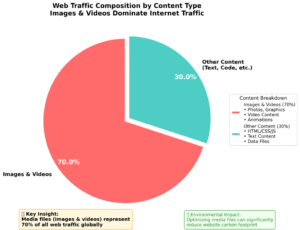How to Audit Your Website for Eco-Friendly SEO (2025 Guide)
Jul 29, 2025 | 3 Min Read | 349 Views

As digital activities account for 4% of global greenhouse gas emissions—equivalent to the aviation industry—eco-friendly SEO has become essential for responsible businesses1. Eco-friendly SEO combines traditional search optimization with sustainable web practices, reducing your website’s carbon footprint while improving performance and user experience.
1.Technical SEO Audit: Building Green Foundations
Begin by evaluating your web hosting provider’s environmental impact. The Green Web Foundation reports that a significant portion of the internet still relies on fossil fuels, but an increasing number of providers are transitioning to renewable energy sources. SiteGround powers its infrastructure with 100% renewable energy through Google Cloud, ensuring carbon-neutral hosting2. Google’s Core Web Vitals directly correlate with energy efficiency—faster sites consume less energy per user interaction3.
Code Optimization Audit your website’s technical efficiency:
- Minimize HTTP requests by combining CSS/JS files
- Compress images using WebP format (reduces file sizes by 25-35%)
- Enable GZIP compression to reduce data transfer
- Remove unused plugins and code bloat
2.Content Audit: Quality Over Quantity
Focus on creating high-value, evergreen content that serves users long-term rather than producing frequent, low-value posts. The UN Environment Programme emphasizes that sustainable digital practices include reducing unnecessary content creation4.
Audit existing content to:
- Consolidate similar pages
- Update outdated information instead of creating new pages
- Optimize content for featured snippets to reduce user search time

3.UX Audit: Energy-Efficient Design
Digital sustainability begins with user-centric design. Research shows that energy-efficient UX practices not only improve performance but also significantly reduce a website’s carbon footprint. Sustainable design principles, such as passive solar design and efficient HVAC systems, can reduce a building’s energy consumption by 50% or more, resulting in lower operational costs and a smaller environmental footprint:
- Use dark mode options (OLED screens consume 63% less power with dark themes)
- Optimize images and videos—they account for 70% of web traffic
- Implement lazy loading for below-the-fold content
- Choose system fonts over custom web fonts

4.Tracking and Measurement: Monitor Your Impact
Quantifying your website’s carbon footprint is the first step toward meaningful reductions. Digital emissions are often overlooked despite the internet’s global carbon output rivaling aviation emissions. You can use these tools to measure your website’s environmental impact:
- Website Carbon Calculator: Measures CO₂ per page visit
- Ecograder: Comprehensive sustainability scoring
- Google PageSpeed Insights: Correlates performance with energy efficiency
The average website produces 0.8g CO₂ per page view. A site with 10,000 monthly visitors generates 102kg CO₂ annually—equivalent to a 450km car journey6.
Conclusion: Take Action Today
Eco-friendly SEO isn’t just about environmental responsibility—it’s smart business. Sustainable websites typically load 2-3x faster, rank higher in search results, and provide better user experiences.
Start your eco-friendly SEO audit today:
Check your hosting provider’s renewable energy usage
Run a website carbon calculator assessment
Optimize your three highest-traffic pages
Set monthly carbon footprint reduction goals
Want to see what Green SEO can do for your brand? Drop us a message here — we’d love to hear from you.
References:
2.SiteGround. (n.d.). Green Web Hosting and SiteGround’s Commitment to Sustainability. Retrieved from
3.Google (2024). “Core Web Vitals and Performance Metrics.”
4.United Nations Environment Programme (2023). “Digitalization for Sustainability.”
6.HTTP Archive (2024). “Web Almanac 2024 – Sustainability Chapter.”








